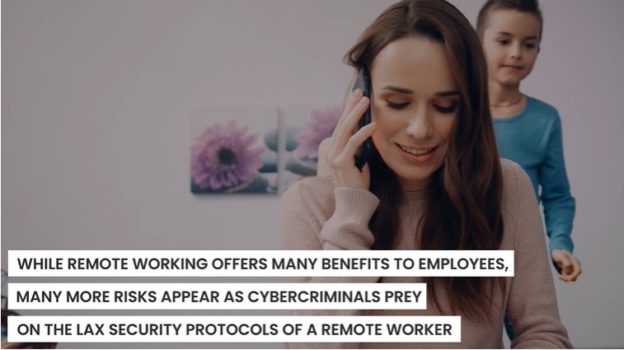Remote workers threaten 1 in 3 businesses
Here are some tips to promote safe remote working. All of these are equally important.
Make sure you understand best practices. Now more than ever it’s important for you to stay up to date on cybersecurity. If your organization has an ongoing training program, make sure you’re actively participating. Scams like phishing only INCREASE when employees are working remotely – you must stay in the know on current threats and best practices.
Make sure you understand your organization’s policies and procedures. If you’re working remotely, your organization should have a Remote Work Policy. Make sure you have read and understood that policy and what is expected of you. You should also continue following ALL company policies and procedures as if you were in the office.
Don’t use public Wi-Fi for work. Work should be done from a secured network, preferably in a home environment and with company equipment. It is also highly recommended that you connect to your company’s network with a Virtual Private Network (VPN). If you are unsure of how to do that, contact your supervisor or IT for more information.
Keep all software up to date. Updates/patches are often released to address security flaws and other loopholes or risk factors. Keeping all devices and software updated is critical in preventing unauthorized access.
If possible, use only company-issued devices for work. Do not let friends or family members use your company-issued device.
Do not use your company-issued device for personal use. It is advised to stay off social media, shopping sites, or any other websites you may visit in your free time when using a company-issued device. Only do secure, company work on company devices and time.
Be mindful of where you save files and data. Do not save files on your local or personal hard drives that may be more likely to be breached.
Back up your files. If you’re unsure of your company’s backup procedure, contact your supervisor or IT. It is very important to back up your work that way if a local loss occurs, data can be more easily recovered.
Use strong, unique passwords. Make sure your passwords for your device and all of your accounts are strong and unique. Never reuse the same password across multiple accounts, and do not share your passwords with others.
Lock screens when not in use. This helps limit any unauthorized access to the information you may still have open on your system.
Having regular check-ins with your team members via video conference is a great way to answer any questions that they may have during this time, to keep engagement high, and to help keep safe practices in place.
Remember, smart cybersecurity does not take a break when the office is empty. Employees may get more comfortable with their work from home role, but we cannot let them forget to keep cybersecurity as a top concern.
If you are unsure about how to practice safe remote working, we can help you identify practices that will help to foster success during this time – and be prepared for any future moments that will require the same diligence.
Request your No-cost Work from Home Securely Resources
Work from Home Guides
Do’s and Don’ts Graphics
No-cost cybersecurity awareness training course

